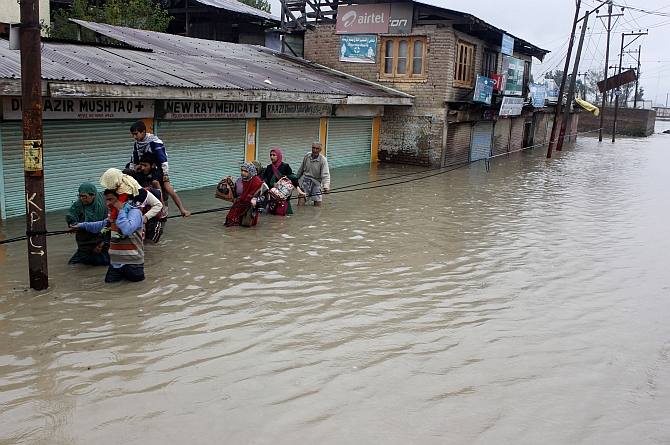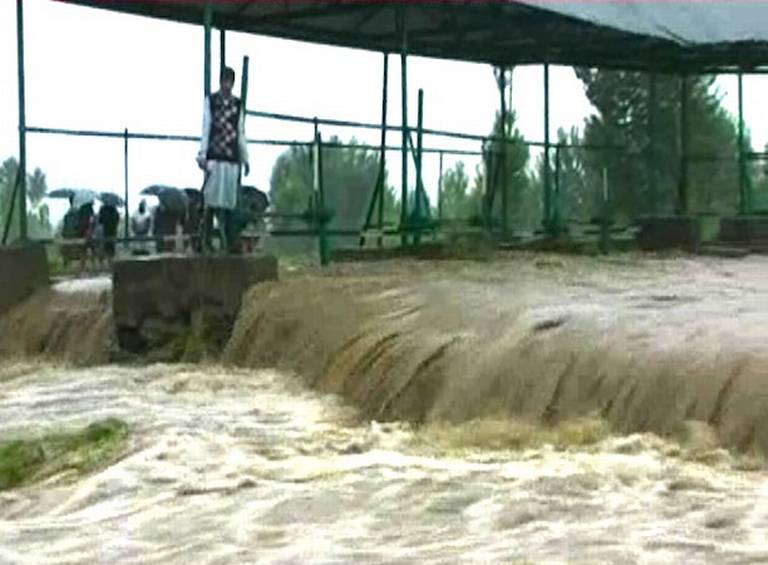Combination Of Man's Greed And Climate Change Could Be Behind Kashmir Disaster
By Marianne de Nazareth
17 September, 2014
Countercurrents.org

Walls of swirling brown water, homes and buildings on the banks of the Jhelum being washed away like little match boxes, shades of the Kedarnath tragedy was the thought that crossed one's mind watching TV footage of the Kashmir tragedy. The recent disaster in Kashmir Valley is being increasingly looked at as having been compounded by man, aggravated by reckless “developmental” activities with no regard for nature conservation. On the same lines, the very same lines as Kedarnath.
As Jammu and Kashmir continues to reel under its worst floods in 60 years, which have stranded over 6 lakh people and killed about 200, the attention is slowly veering towards the reasons and causes behind this unprecedented natural disaster. An analysis by Centre for Science and Environment (CSE) suggests that this could very well be another manifestation of an extreme weather event – induced by climate change.
“The Kashmir floods are a grim reminder that climate change is now hitting India harder. In the last 10 years, several extreme rainfall events have rocked the country, and this is the latest calamity in that series,” said Chandra Bhushan, CSE deputy director general and the head of its climate change team.
Reasearcher in the CSE say there is a list of such extreme events including the Mumbai floods of 2005, the Leh cloudburst of 2010 and the Uttarakhand floods of 2013. In each of these disasters, thousands have died and the economic losses incurred have run into thousands of crores of rupees hitting the country hard.
Looking back at the cases of previous extreme rainfall events, the scale of disaster in J&K has been exacerbated by unplanned development – especially on the riverbanks. In the last 100 years, more than 50 per cent of the lakes, ponds and wetlands of Srinagar have been encroached upon to construct buildings and roads. The banks of the Jhelum river have been taken over in a similar manner, vastly reducing the river's drainage capacity. This is where loss of life and man- made structures have been the most affected.
The tragedy in J&K, says Chandra Bhushan, is that the state has not been prepared to handle such extreme rainfall events. In fact, J&K does not have a flood forecasting system. Its disaster management system is also rudimentary.
Scientists say climate models predict that India will be hit more and more by extreme rainfall events. Heavy and very heavy rainfall events in India has increased over the past 50-60 years. A study done by B. N. Goswami of Indian Institute of Tropical Meteorology, Pune, shows that between 1950 and 2000, the incidence of heavy rainfall events (> 100 mm/day) and very heavy events (>150 mm/day) have increased and moderate events (5-100 mm/day) have decreased.

Most climate models also predict that India will be hit more and more by extreme rainfall events as the world continues to warm in the coming decades. According to the latest analysis by the Working Group II of the IPCC Assessment Report (AR5), floods and droughts are likely to increase in India. India will get more rainfall but it wont be spread over a number of days. Increase in extreme precipitation during monsoons is also predicted. The IPCC's 2011 Special Report on Managing the Risks of Extreme Events and Disasters to Advance Climate Change Adaptation, presents projections for the period 2071-2100. It points to increasing incidents of more frequent and intense heavy precipitation over most regions.
So a wise country should look to the future and take some steps to safeguard itself. Sunita Narain, director general of CSE, says: To begin with, the Indian government must discard its ostrich-like policy and get out of its denial mode. We will have to see the linkages between climate change and the events such as those unfolding in J&K. We will have to accept that climate change is going to affect us more and more in the future. We will, therefore, have to start preparing to adapt to the changing climate.”
India should start internalising climate change adaptation in all developmental policies and programme. From building of cities infrastructure to agriculture and from water supply to energy infrastructure, we will have make changes to incorporate climate change impacts, says Narain.
Chandra Bhushan adds: “India will also have to proactively work with other countries to reduce emissions to control the warming of the planet. Most studies show that India is one of the most vulnerable countries. A warmer planet will affect India severely – and its poor would be the worst impacted.”
The Bombay Natural History Society of India says that studies in the valley over the years reveal that there has been a severe loss of wetland habitat for various commercial activities. Hence, BNHS feels that the recent floods can be clearly termed as an “Ecological Disaster” and highlights the urgency to enact Wetland (Conservation) Act, on the pattern of Forest (Conservation) Act, 1980.
It is obvious from field studies that there has been a massive loss of wetlands in the Kashmir valley over the years. For instance, the famed Dal Lake in Srinagar has seen numerous reclamations all along its periphery in the marshy areas. This has drastically reduced the lake area to just about 1,200 hectares, which is almost half of its earlier spread. The vast expanse of Wular Lake and associated marshes – an Important Bird Area (IBA) - is another case in point. Once spread across 20,200 hectares, it now remains restricted to a mere 2,400 hectares. In the last 30 years, nearly 50% of the wetlands in the Kashmir Valley have been encroached upon or severely damaged.
Dr Asad Rahmani, Director, BNHS, speaking on the floods said, “This can be termed as an Ecological Disaster. The disastrous damage caused to life and property could have been minimized if the large number of wetlands that once existed in the Valley, had been preserved. Wetlands act as a sponge that retains excess water. Wular Lake is a classic example”. Even the British and former Maharajas of Kashmir used to consider Wular as a buffer for the floods, where excess water could be absorbed.
Wrong policies on the part of successive governments in the state have contributed to the wetland loss. For example, encroachment upon the shallow portions of the wetland by the forest department for plantation of Willow trees has significantly reduced the size of Wular Lake over the years.
Kashmir Valley has one narrow opening towards the west for the water from the catchment areas to be drained into the Jhelum River. From all other sides, it is encircled by high mountains. The need for the Wetland Conservation Act is imperative. During the reign of the Maharajas of Kashmir, a well functioning water drainage system that was synchronous with the natural topography of the region was in place. The same lay neglected in the recent decades. The myriads of lakes and wetlands of the valley, which acted as sponges, were also well preserved in the past. Considering the importance of wetlands, not just in Jammu and Kashmir, but across India, Dr Rahmani recommends the passing of a Wetland (Conservation) Act on the lines of the Forest (Conservation) Act needs to be implemented.
Protection of wetlands will not only help in flood control, but will also help in recharging the ground water levels across the country and thus ensure better food security by way of increased water availability. Although the Central Wetlands Regulatory Authority exists at present, it has been proving ineffective in saving the wetlands. Dr Rahmani added that it is also important not to classify wetlands as wastelands, as wetlands play an important biological, cultural, economical, aesthetic and spiritual role.
(Freelance Science and Environment Journalist, PhD scholar and adjunct faculty St. Joseph's PG College of Media Studies, Bangalore, India)
DONATE TO KASHMIR FLOOD VICTIMS HERE
Comments are moderated
